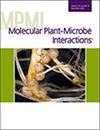Eliza P I Loo, Boris Szurek, Yugander Arra, Melissa Stiebner, Marcel Buchholzer, B N Devanna, Casiana M Vera Cruz, Wolf B Frommer
求助PDF
{"title":"Closing the Information Gap Between the Field and Scientific Literature for Improved Disease Management, with a Focus on Rice and Bacterial Blight.","authors":"Eliza P I Loo, Boris Szurek, Yugander Arra, Melissa Stiebner, Marcel Buchholzer, B N Devanna, Casiana M Vera Cruz, Wolf B Frommer","doi":"10.1094/MPMI-07-24-0075-FI","DOIUrl":null,"url":null,"abstract":"<p><p>A path to sustainably reduce world hunger, food insecurity, and malnutrition is to close the crop yield gap and, particularly, lower losses due to pathogens. Breeding resistant crops is key to achieving this goal, which is an effort requiring collaboration among stakeholders, scientists, breeders, farmers, and policymakers. During a disease outbreak, epidemiologists survey the occurrence of a disease after which pathologists investigate mechanisms to stop an infection. Policymakers then implement strategies with farmers and breeders to overcome the outbreak. Information flow from the field to the lab and back to the field involves several processing hubs that require different information inputs. Failure to communicate the necessary information results in the transfer of meaningless data. Here, we discuss gaps in information acquisition and transfer between the field and laboratory. Using rice bacterial blight disease as an example, we discuss pathogen biology and disease resistance to point out the importance of reporting pathogen strains that caused an outbreak to optimize the deployment of resistant crop varieties. We examine differences between infection in the field and assays performed in the laboratory to draw awareness of possible misinformation concerning plant resistance or susceptibility. We discuss key data considered useful for reporting disease outbreaks, sampling bias, and suggestions for improving data quality. We also touch on the knowledge gap in the state-of-the-art literature regarding disease dispersal and transmission. We use a recent case study to exemplify the gaps mentioned. We conclude by highlighting potential actions that may contribute to food security and to closing the yield gap. [Formula: see text] Copyright © 2025 The Author(s). This is an open access article distributed under the CC BY 4.0 International license.</p>","PeriodicalId":19009,"journal":{"name":"Molecular Plant-microbe Interactions","volume":" ","pages":"134-141"},"PeriodicalIF":3.4000,"publicationDate":"2025-03-01","publicationTypes":"Journal Article","fieldsOfStudy":null,"isOpenAccess":false,"openAccessPdf":"","citationCount":"0","resultStr":null,"platform":"Semanticscholar","paperid":null,"PeriodicalName":"Molecular Plant-microbe Interactions","FirstCategoryId":"99","ListUrlMain":"https://doi.org/10.1094/MPMI-07-24-0075-FI","RegionNum":3,"RegionCategory":"生物学","ArticlePicture":[],"TitleCN":null,"AbstractTextCN":null,"PMCID":null,"EPubDate":"2025/1/24 0:00:00","PubModel":"Epub","JCR":"Q2","JCRName":"BIOCHEMISTRY & MOLECULAR BIOLOGY","Score":null,"Total":0}
引用次数: 0
引用
批量引用
Abstract
A path to sustainably reduce world hunger, food insecurity, and malnutrition is to close the crop yield gap and, particularly, lower losses due to pathogens. Breeding resistant crops is key to achieving this goal, which is an effort requiring collaboration among stakeholders, scientists, breeders, farmers, and policymakers. During a disease outbreak, epidemiologists survey the occurrence of a disease after which pathologists investigate mechanisms to stop an infection. Policymakers then implement strategies with farmers and breeders to overcome the outbreak. Information flow from the field to the lab and back to the field involves several processing hubs that require different information inputs. Failure to communicate the necessary information results in the transfer of meaningless data. Here, we discuss gaps in information acquisition and transfer between the field and laboratory. Using rice bacterial blight disease as an example, we discuss pathogen biology and disease resistance to point out the importance of reporting pathogen strains that caused an outbreak to optimize the deployment of resistant crop varieties. We examine differences between infection in the field and assays performed in the laboratory to draw awareness of possible misinformation concerning plant resistance or susceptibility. We discuss key data considered useful for reporting disease outbreaks, sampling bias, and suggestions for improving data quality. We also touch on the knowledge gap in the state-of-the-art literature regarding disease dispersal and transmission. We use a recent case study to exemplify the gaps mentioned. We conclude by highlighting potential actions that may contribute to food security and to closing the yield gap. [Formula: see text] Copyright © 2025 The Author(s). This is an open access article distributed under the CC BY 4.0 International license.
缩小田间与科学文献之间的信息差距,改善病害管理--重点关注水稻和细菌性枯萎病。
可持续地减少世界饥饿、粮食不安全和营养不良的途径是缩小作物产量差距,特别是病原体造成的损失。培育抗病作物是实现这一目标的关键,需要利益相关者、科学家、育种家、农民和决策者通力合作。在疾病爆发期间,流行病学家会调查疾病的发生情况,然后病理学家会研究阻止感染的机制。然后,政策制定者与农民和育种者一起实施战略,以克服疾病的爆发。从田间到实验室再到田间的信息流涉及多个处理中心,需要不同的信息输入。如果不能传递必要的信息,就会导致毫无意义的数据传输。在此,我们将讨论田间和实验室之间在信息获取和传递方面存在的差距。以水稻细菌性枯萎病为例,我们讨论了病原体生物学和抗病性,指出报告导致疫情爆发的病原体菌株对于优化抗病作物品种部署的重要性。我们探讨了田间感染与实验室检测之间的差异,以提醒人们注意植物抗性或易感性方面可能存在的错误信息。我们讨论了对报告疾病爆发有用的关键数据、取样偏差以及提高数据质量的建议。我们还探讨了最新文献中有关病害扩散和传播的知识空白。我们用最近的一个案例研究来举例说明上述差距。最后,我们强调了可能有助于粮食安全和缩小产量差距的潜在行动。
本文章由计算机程序翻译,如有差异,请以英文原文为准。

 求助内容:
求助内容: 应助结果提醒方式:
应助结果提醒方式:


